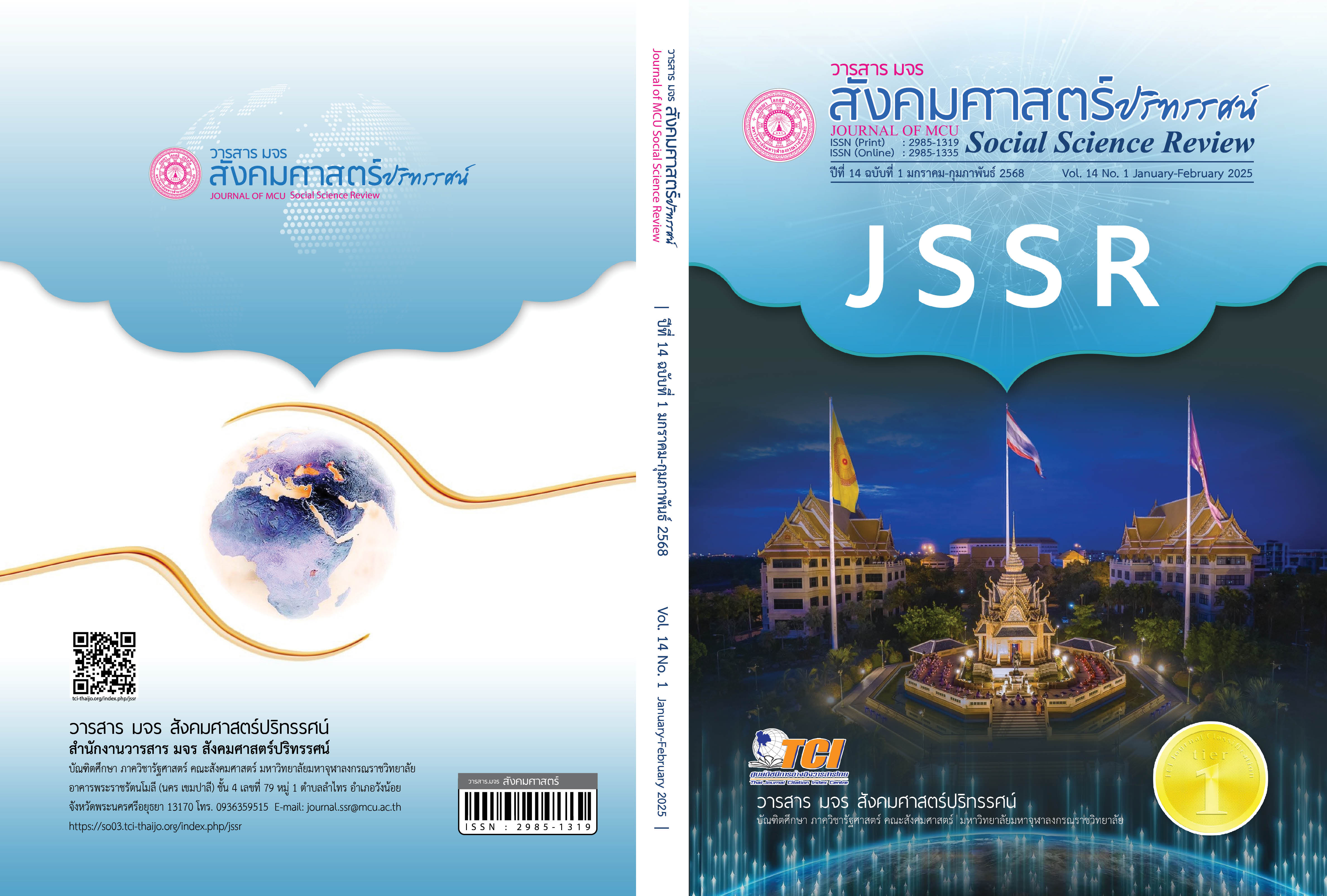การบูรณาการเทคโนโลยีดิจิทัลกับการบริหารการปกครองส่วนท้องถิ่น : กรณีศึกษาการพัฒนาระบบบริการสาธารณะในยุคดิจิทัล
คำสำคัญ:
การบูรณาการเทคโนโลยีดิจิทัล, การปกครองส่วนท้องถิ่น, การให้บริการสาธารณะบทคัดย่อ
บทความวิจัยครั้งนี้มีวัตถุประสงค์ 1. ศึกษาระดับ ของตัวแปร ด้านการยอมรับเทคโนโลยี ทรัพยากรและความสามารถ การบริหารจัดการทรัพยากร การใช้เทคโนโลยีดิจิทัลที่ส่งผลต่อการบูรณาการเทคโนโลยีดิจิทัลกับการบริหารการปกครองส่วนท้องถิ่น 2. ศึกษาความสัมพันธ์ของตัวแปรระหว่าง การยอมรับเทคโนโลยี ทรัพยากรและความสามารถ
การบริหารจัดการทรัพยากร การใช้เทคโนโลยีดิจิทัล ที่ส่งผลต่อการบูรณาการเทคโนโลยีดิจิทัลกับการบริหารการปกครองส่วนท้องถิ่น และ 3. วิเคราะห์ปัจจัยเชิงสาเหตุของ การยอมรับเทคโนโลยี ทรัพยากรและความสามารถ การบริหารจัดการทรัพยากร การใช้เทคโนโลยีดิจิทัล
ที่ส่งผลต่อการบูรณาการเทคโนโลยีดิจิทัลกับการบริหารการปกครองส่วนท้องถิ่น โดยศึกษาจากประชากร คือ กลุ่มผู้บริหารองค์กรปกครองส่วนท้องถิ่น ทั้งประเทศไทย คำนวนได้ขนาดของกลุ่มตัวอย่างได้ 667 ตัวอย่าง ทำการวิเคราะห์ทางสถิติด้วย โมเดลสมการโครงสร้าง แบบวิธี PLS-SEM กำหนดค่าความเชื่อมั่นที่ .05
ผลการวิจัยพบว่า การยอมรับเทคโนโลยีและทรัพยากรมีบทบาทสำคัญในการเพิ่มประสิทธิภาพของการบริหารจัดการและการใช้เทคโนโลยีดิจิทัลในองค์กรปกครองส่วนท้องถิ่น ทั้งนี้ การบูรณาการเทคโนโลยีดิจิทัลช่วยเสริมสร้างความโปร่งใส การตอบสนองต่อความต้องการของประชาชน และความยั่งยืนของการให้บริการสาธารณะ งานวิจัยนี้ยังให้ข้อเสนอแนะเกี่ยวกับการพัฒนาทรัพยากรบุคคล การลงทุนในโครงสร้างพื้นฐานทางเทคโนโลยี และการวิจัยเพิ่มเติมเพื่อประเมินผลลัพธ์ของการใช้เทคโนโลยีดิจิทัลในองค์กรปกครองส่วนท้องถิ่น ผลการวิจัยสามารถนำไปใช้ในการพัฒนานโยบายและกลยุทธ์ที่เหมาะสมสำหรับการบริหารการปกครองส่วนท้องถิ่นในยุคดิจิทัลได้อย่างมีประสิทธิภาพ
เอกสารอ้างอิง
กรมส่งเสริมการปกครองส่วนท้องถิ่น. (2567). ข้อมูลองค์กรปกครองส่วนท้องถิ่น. เรียกใช้เมื่อ 15 พฤศจิกายน 2567, จาก https://www.dla.go.th/work/abt/index.jsp
กฤษดา ประชุมราศี. (2565). การประเมินการตอบสนองของการประยุกต์ใช้เครื่องมือดิจิทัลในการรับเรื่องร้องทุกข์ขององค์กรปกครองส่วนท้องถิ่น: กรณีศึกษา เทศบาลนครขอนแก่น. วารสาร มจร สังคมศาสตร์ปริทรรศน์, 11(6), 364-373.
ดวงสมร สุทธิวงศ์กูล. (2563). การพัฒนาทักษะดิจิทัลของบุคลากรภาครัฐไทยสู่การเป็นรัฐบาลดิจิทัล. วารสารการเมือง การบริหาร และกฎหมาย, 13(1), 197-216.
ธัญญภัสร์ วีรลักษมีภรณ์ และคณะ. (2567). การพัฒนาผู้บริหารสถานศึกษาในยุคดิจิทัล. วารสารมณีเชษฐาราม วัดจอมมณี, 7(5), 1214-1223.
พระมหาอดิศักดิ์ คเวสโก และคณะ. (2565). รัฐบาลอิเล็กทรอนิกส์ : พลังแห่งการขับเคลื่อนการให้บริการสาธารณะของภาครัฐไทย. วารสารมณีเชษฐาราม วัดจอมมณี, 5(2), 252-266.
เมธาสิทธิ์ จันทรเสวต และคณะ. (2567). การยอมรับเทคโนโลยีเพื่อการปรับตัวเข้าสู่องค์กรดิจิทัลของบุคลากรองค์การบริหารส่วนตำบลหนองปรือ อำเภอบางพลี จังหวัดสมุทรปราการ. วารสารมหาจุฬาคชสาร, 15(1), 323–338.
วชิรพัฒน์ หวังหมู่กลาง และคณะ. (2567). การปรับตัวขององค์กรปกครองท้องถิ่นสู่ระบบราชการ 4.0 ด้วยนวัตกรรม. วารสารการบริหารการจัดการและการพัฒนาที่ยั่งยืน, 2(3), 268-701.
วันชัย มีชาติ. (2565). การปรับตัวขององค์การภาครัฐสู่รัฐบาลดิจิทัล: ศึกษากรณีการปรับตัวของกระทรวงการต่างประเทศสู่การเป็นรัฐบาลดิจิทัลตามกรอบของแผนพัฒนารัฐบาลดิจิทัลของประเทศไทย ปี พ.ศ. 2563-2565 (สารนิพนธ์รัฐประศาสนศาสตรมหาบัณฑิต สาขาวิชารัฐประศาสนศาสตร์. กรุงเทพฯ: จุฬาลงกรณ์มหาวิทยาลัย.
สกล สุขเสริมส่งชัย และคณะ. (2565). การจัดการปกครองในรัฐบาลดิจิทัลในประเทศไทย. วารสารการบริหารและสังคมศาสตร์ปริทรรศน์, 5(4), 41-48.
สมชาติ ดีอุดม และคณะ. (2567). อิทธิพลขององค์ประกอบการยอมรับเทคโนโลยีต่อสมรรถนะในการใช้เทคโนโลยีสารสนเทศของอาสาสมัครสาธารณสุข ประจำหมู่บ้านเพื่อส่งเสริมประสิทธิภาพการปฏิบัติงาน. วารสารปาริชาติ, 37(4), 938-955.
สุชัมบดี ขาวขำ และคณะ. (2567). รูปแบบความร่วมมือเชิงบูรณาการในการจัดบริการสาธารณะขององค์กรปกครองส่วนท้องถิ่นในพื้นที่จังหวัดอุดรธานี. วารสารสังคมศาสตร์และวัฒนธรรม, 8(6), 61-72.
อรนุช ศรีอินทร์ และคณะ. (2567). ระบบบริหารจัดการทรัพยากรมนุษย์แบบบูรณาการหอสมุดแห่งมหาวิทยาลัยธรรมศาสตร์ (TULIB-HR). PULNET Journal, 11(2), 54–71.
Barney, J. (1991). Firm resources and sustained competitive advantage. Journal of Management, 17(1), 99-120.
Bekkers, V. & Homburg, V. (2007). The Myths of E-Government: Looking Beyond the Assumptions of a New and Better Government. The Information Society, 23(5), 373-382.
Cronbach, L. J. (1951). Coefficient alpha and the internal structure of tests. Psychometrika, 16, 297-334.
Davis, F. D. (1989). Perceived Usefulness, Perceived Ease of Use, and User Acceptance of Information Technology. MIS Quarterly, 13(3), 319-340.
Erete, S. & Burrell, J. O. (2017). Empowered Participation: How Citizens Use Technology in Local Governance. Retrieved March 20, 2024, from https://shorturl.asia/dm3UH
Hair, J. F. et al. (2010). Multivariate Data Analysis: A Global Perspective. Upper Saddle River.
Jusoh, Z. et al. (2018). Validity Evidence Using Expert Judgment: A Study of Using Item Congruence Involving Expert Judgements for Evidence for Validity of A Reading Test. Al-Shajarah: Journal of The International Institute of Islamic Thought and Civilization (Istac), (Special Issue: Education 2018), 307-320.
Moon, M. J. (2002). The Evolution of E-Government among Municipalities: Rhetoric or Reality?. Public Administration Review, 62(4), 424-433.
Rovinelli, R. J. & Hambleton, R. K. (1977). On the Use of Content Specialists in the Assessment of Criterion-Referenced Test Item Validity. Tijdschrift Voor Onderwijs Research, 2, 49-60.
ดาวน์โหลด
เผยแพร่แล้ว
รูปแบบการอ้างอิง
ฉบับ
ประเภทบทความ
สัญญาอนุญาต
ลิขสิทธิ์ (c) 2025 วารสาร มจร สังคมศาสตร์ปริทรรศน์

อนุญาตภายใต้เงื่อนไข Creative Commons Attribution-NonCommercial-NoDerivatives 4.0 International License.
เพื่อให้เป็นไปตามกฎหมายลิขสิทธิ์ ผู้นิพนธ์ทุกท่านต้องลงลายมือชื่อในแบบฟอร์มใบมอบลิขสิทธิ์บทความให้แก่วารสารฯ พร้อมกับบทความต้นฉบับที่ได้แก้ไขครั้งสุดท้าย นอกจากนี้ ผู้นิพนธ์ทุกท่านต้องยืนยันว่าบทความต้นฉบับที่ส่งมาตีพิมพ์นั้น ได้ส่งมาตีพิมพ์เฉพาะในวารสาร มจร สังคมศาสตร์ปริทรรศน์ เพียงแห่งเดียวเท่านั้น หากมีการใช้ภาพหรือตารางหรือเนื้อหาอื่นๆ ของผู้นิพนธ์อื่นที่ปรากฏในสิ่งตีพิมพ์อื่นมาแล้ว ผู้นิพนธ์ต้องขออนุญาตเจ้าของลิขสิทธิ์ก่อน พร้อมทั้งแสดงหนังสือที่ได้รับการยินยอมต่อบรรณาธิการ ก่อนที่บทความจะได้รับการตีพิมพ์ หากไม่เป็นไปตามข้อกำหนดเบื้องต้น ทางวารสารจะถอดบทความของท่านออกโดยไม่มีข้อยกเว้นใดๆ ทั้งสิ้น





